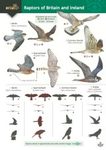Monograph
By: Marian Cieślak(Author)
206 pages, colour photos, b/w illustrations, colour & b/w tables
![Feathers of European Owls Feathers of European Owls]()
Click to have a closer look
About this book
Contents
Customer reviews
Related titles
About this book
Language: English
Marian Cieślak (1950 – 2016) became one of the few researchers in Europe to commence with scientific study of bird feathers, and most especially – the feathers of birds of prey and owls. This resulted in the first guide to feathers published in Polish (in 1999). Presented there were baseline details on how to identify the feathers of selected bird species enjoying legal protection (mainly birds of prey and owls). In his publications, Marian Cieślak noted repeatedly how the identification of bird feathers was one of the least-developed areas of applied ornithology – and all the more so when set against, for example, flight identification, or the identification of calls, nests and eggs. This was therefore the inspiration for further research into feathers resulting in the release of another book – Feathers: Identification for Bird Conservation (Cieślak and Dul 2006); which was published in both Polish and English. In the years that followed, the research focus homed in on the ecology of owls, and in particular the relationship between biology, plumage and the moulting process.
Feathers of European Owls fills many gaps in current knowledge of owl feathers. The author not only describes the identification of feathers of the European owl species, but also presents relationships between feather morphology and the behaviour and ecology of this group of birds. These findings are largely based on the Author's original research, and his extensive collection of feathers.
Contents
Obituary 7
From the publishers 9
Introduction 11
Part A – Description of owl feathers 13
Basic information on feathers 13
Types of feather 13
Wings 18
The tail 21
Specifc features of owl feathers 23
Primaries 23
Secondaries 25
Rectrices (tail feathers) 26
Other smaller feathers 27
Abnormalities in feather numbers 32
Owl feather dimorphism 34
Part B – The ecology of owls and their plumage 39
B1. Analysis of owl silhouettes in flight 39
B2. Wing-loading 44
B3. Feather colouration and pattern 48
The optimised distribution of pigment in the plumage of owls 51
The optimised distribution of pigment in feathers 52
The species-related variability in colouration pattern 53
Aberrations in the colouring of owl plumage 58
Albinism and leucism 58
Melanism 61
B4. The silent flight mechanisms in owls 62
The diversity of silent flight mechanisms in European owl species 70
The auditory abilities of owls 70
Daily activity and type of diet 73
Audiles, generalists and visualisers 74
The silent flight mechanisms in different hunting strategies 77
Silent flight and owls’ aviation capabilities 81
Ecological isolation between owl species 83
B5. Moulting strategies 87
The effect of moulting on owls’ flying abilities 89
The sequence of moulting 90
The frequency of replacement of individual feathers 92
Moult phenology in relation to breeding and migration 93
How long does moulting a generation of feathers take? 95
Feather grow rates 96
B6. Why owls have developed a diastataxic wing type? 98
B7. Stress bars 104
B8. The bioindication of environmental pollution using owl feathers 110
Part C – Species review 113
Western Barn Owl Tyto alba 113
Eurasian Scops Owl Otus scops 116
Eurasian Eagle-Owl Bubo bubo 117
Snowy Owl Bubo scandiacus 119
Northern Hawk-Owl Surnia ulula 121
Eurasian Pygmy Owl Glaucidium passerinum 124
Little Owl Athene noctua 125
Great Grey Owl Strix nebulosa 127
Ural Owl Strix uralensis 131
Tawny Owl Strix aluco 133
Long-eared Owl Asio otus 135
Short-eared owl Asio flammeus 137
Marsh Owl Asio capensis 139
Boreal Owl (Tengmalm’s Owl) Aegolius funereus 141
Part D – Identifcation of feathers from among the European species of owl 143
Variety in owl feathers 144
A feather identifcation procedure 144
Reasons for the presence of feathers 145
Assigning species to groups 145
Large owls 146
Medium-sized owls 155
Small owls 165
Ending 171
Acknowledgments 171
References 173
Appendices 183
Customer Reviews
Monograph
By: Marian Cieślak(Author)
206 pages, colour photos, b/w illustrations, colour & b/w tables




























